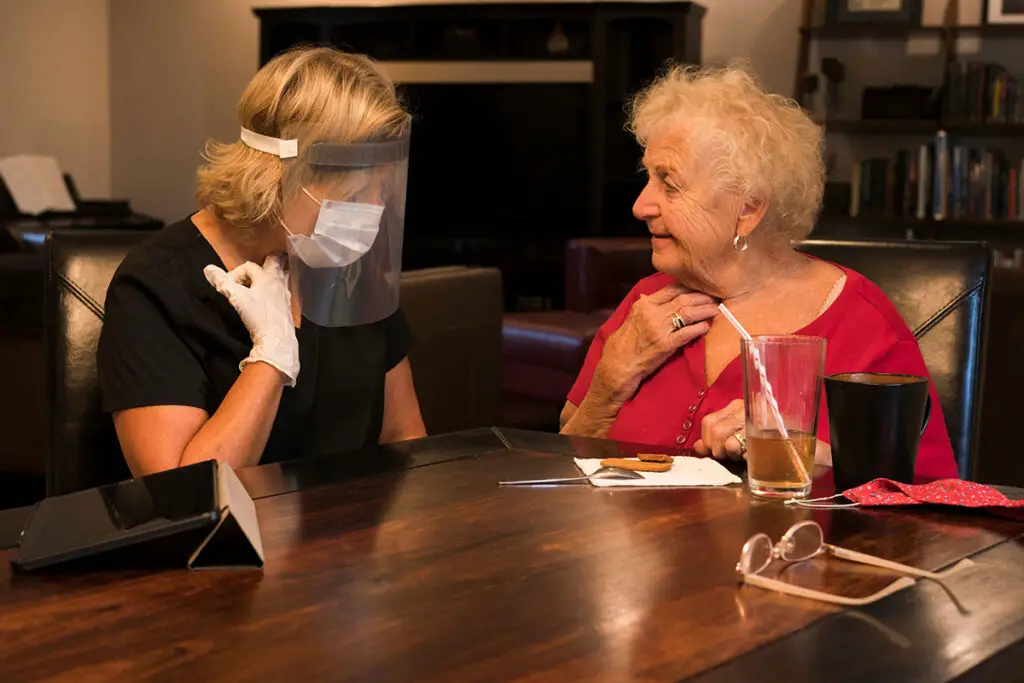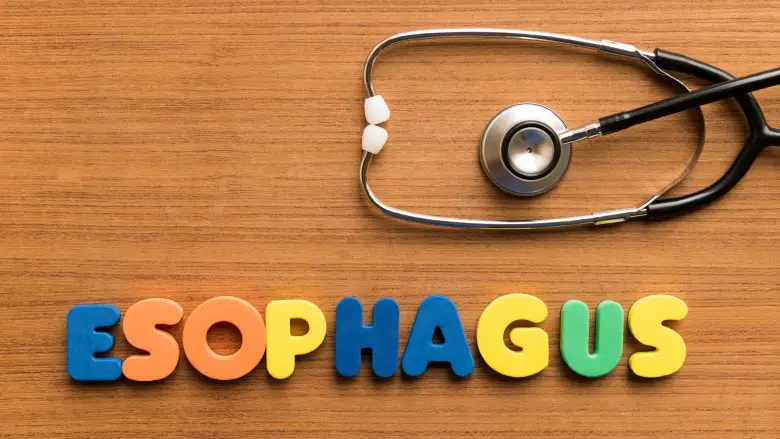Dysphagia is a condition that makes it difficult to swallow. Dysphagia could be induced by a stroke, head injury, multiple sclerosis, or dementia. Cancer and gastro-esophageal- reflux disease (GERD) are other causes. Swallowing difficulty can range from mild inconvenience to complete and painful blockage. This article covers dysphagia with a particular focus on the dysphagia diet, what foods may be better to eat and which should be avoided.
Aging, malnutrition, muscle deterioration and other life events also have negative effects on the normal swallow response. Many neurological disorders and different types of surgery impact what type of food and liquids people can eat and drink while swallowing safely without choking. Severe dental problems, mouth sores, and decreased salivation are also causes of dysphagia.
Symptoms of Dysphagia
When someone has dysphagia, they may have any of the following:
- Pain while swallowing
- Inability to swallow
- A sensation the food is stuck in the throat, chest, or behind the breastbone
Main Considerations of Dysphagia
When someone has dysphagia, choosing which foods are best (and safest) to eat can be a challenge. What type of food texture should they aim for? What are the definitions of the food textures and thickness of liquids (called food rheology, the science of identifying and measuring food textures)?
The acts of chewing and swallowing cause five different effects upon food:
- Compression. The food gets squashed down and is deformed.
- Adhesiveness. The food is attracted to another surface such as the upper roof of the mouth.
- Tensile. The food is pushed by the muscles of the throat down towards the esophagus.
- Shear. Foods are shredded via the molars during chewing.
- Fracture. The foods eaten are broken by two directly opposing forces. For example, when you bite through a cracker, your incisors are contributing to the fracture forces.
If any one of these effects are interfered with, dysphagia will result.
Beyond the Mechanical Diet
Back as far as the early 1990s, dietitians were still using the same principles they had learned in dietitian school for those who had trouble swallowing. The diet for those who had dysphagia was always called a mechanical diet.
Principles of a mechanical diet include:
- Eat smaller meals and more of them.
- Chew food longer and eat more slowly.
- Cut food into smaller pieces.
- Buy liquid thickeners to make swallowing easier.
- Determine which foods are causing the patient the most trouble.
These principles were not enough, however.
The need for a multilevel dysphagia diet was first expressed at a 1996 American Dietetic Association Annual Meeting and Exhibition. After that, the National Dysphagia Diet Task Force (NDDTF) was set up and worked on this project.
They standardized the dietary textures and terminology and created different levels of the Dysphagia Diet so that the food industry, dietitians, patients’ families, caregivers, and healthcare practitioners in many different types of health care facilities as well as the home. would be able to converse intelligently about the plan of action for their patients.
Around that time, the four levels of the dysphagia diet were set up.
4 Levels of the Dysphagia Diet
The four different levels of the dysphagia diet help caregivers and healthcare professionals determine what is the best diet – for consistency – for a patient or family member.
Level 1 – Dysphagia Diet
This diet is primarily pureed or smooth foods such as pudding. All foods must be able to be swallowed without chewing. Thus, yogurt, smooth soups, pureed vegetables and meats, and mashed potatoes with gravy are allowed. Follow puree food recipes if you are making your own food or food for a loved one.
Level 2 – Dysphagia Diet
More foods are included at this level, but they must be at least moist. Some chewing is okay. The list of these foods would include foods like soft scrambled eggs, cottage cheese, peanut butter, soft/ground meats, soft cooked or mashed fruits or vegetables, and foods that are moist because of added gravy. Foods on this diet do not include crackers, nuts, and other dry foods.
Level 3 – Dysphagia Diet
Each level of the dysphagia diet needs a higher level of chewing. Meat, fruit, vegetables that may be cut up or mashed are included on this diet. However, crunchy, sticky, or very dry foods are not allowed. Crackers, chips, nuts, and other snack foods are not allowed as well.
Level 4 – Dysphagia Diet
All foods are allowed.
Besides these different levels, you may have to drink thick water. The way to do this is to add a gel, gum, powder, or other liquid to thin liquids. These should be flavorless. It’s also possible to purchase pre-thickened liquids.
- VALUE SIZE; 36 oz canister
- CONVENIENT: Dissolves instantly
It’s still important to get enough liquids, even if it’s difficult to get them down. Not enough liquids taken in can lead to dehydration, which leads to other health problems.
Good Foods for Dysphagia
If you or your loved one has dysphagia, the diet will be compromised. There is simply now way around that. You can, however, get creative in your foods and create more options than you might otherwise think. Dysphagia is not uncommon and there are even dysphagia cookbooks available.
- Robinson, Audrey (Author)
- English (Publication Language)
Below is a list of foods that generally work for those with dysphagia.
- Oatmeal
- Cold cereal moistened with milk
- Macaroni and cheese that is moist
- Pasta that is well-cooked and soft and has meat sauce
- Pancakes or French Toast moistened with syrup
- Potatoes that are mashed, baked, boiled, well cooked
- Eggs that are soft cooked, scrambled or poached
- Tofu
- Egg salads or tuna salads with no chunks, no celery and no onion
- Slightly mashed and moist baked beans
- Meats/poultry/fish served with gravy or sauces that are moist, ground and finely diced
- Applesauce, pudding, custard
- Ice cream, sorbet, jello, and sherbert
- Cobblers with no seeds or nuts and with soft crumb mixture
- Soft and ripe bananas
- Canned fruit that is soft and drained
- Soft, cooked vegetables that are tender to the fork, and diced in small pieces < ½ inch
Foods to Avoid
Below is a list of foods to avoid:
- Chips
- Cereals that have seeds, nuts, or small bits of other foods in them
- Dry breads and rolls
- Raw fruits
- Raw vegetables
- Cooked corn
- Cooked peas
- Cooked pineapple
- Fresh pineapple
- Canned pineapple
- Broccoli or cabbage
- Cakes or cookies that are not moist
- Rice pudding
- Bread pudding
- Hard candies
- Hot dogs
- Sausage
- Bacon
- Sandwiches
- Peanut butter
- Dry, tough meats
What Foods Repair the Esophagus
Here’s a list of foods, herbs or nutrients that may assist with repair of the esophagus:
- Slippery elm – heals all mucosal membranes in the body.
- Diatomaceous earth – heals all connective tissue.
- Pantothenic acid – stimulates healing especially for burns.
- Foods that someone is sensitive to – Food sensitivities may cause sudden dysphagia, such as eating a certain food that contains a specific pesticide or chemical.
- Collagen protein drinks – To heal the body, it takes extra protein.
- Foods that stimulate stem cell growth factors – Spirulina and many herbs fall into this category.
- Zinc-L-carnosine – This form of zinc is very specific to heal GI system tissue.
How to Treat Dysphagia Naturally
Treating dysphagia naturally starts with determining the cause. If the cause is a neurological disorder such as Parkinson’s disease, the neurological disorder needs to be addressed first and foremost. If the cause is a head trauma, some studies have shown that red light therapy has been helpful – and that most medical treatments are not working.
If the problem is GERD, then the GERD must be addressed. Many of my patients have been able to heal their esophagus with kefir milk that is unflavored over the course of about six weeks. If there are ulcerations, surgical tears or injuries, or even burns, then slippery elm, diatomaceous earth (USDA food grade only), and pantothenic acid in higher doses can help generate new tissue pretty quickly.
Collagen protein drinks must also be taken because the generation of new tissue needs collagen protein, and many people don’t eat enough protein per day to meet their daily needs, let alone their needs for protein for new tissue regeneration.
Food sensitivities may occur because of a leaky gut; thus, in this case, healing the GI tract is the most important thing to address. Secondarily, addressing all vitamin and mineral deficiencies is called for, and a vitamin/mineral protocol must be set up to start the healing process.
Zinc-L-carnosine works well for healing many ulcerations of the GI tract and mucosal membranes as well. However, a full and comprehensive nutritional workup often reveals many different vitamin and mineral deficiencies, and all of them must be taken care of. In one study from France, 36 to 70% of the 14 patients with esophageal stenosis (blockage) had the following deficiencies: iron, vitamin D, vitamin B6, zinc, and selenium. Protein deficiency, vitamin C, and carnitine deficiencies were also seen.
If the dysphagia is due to teeth problems, the teeth will have to be taken care of. Always consider any secondary problems to the patient’s health that result as well.
For example, if someone is unable to chew foods, their nutrition is compromised. Thus, a full nutritional workup is necessary. This could include blood tests such as a complete blood chemistry (CBC), blood chemistry, separate vitamin and mineral tests (selenium, vitamin A, vitamin D, Folic acid, vitamin B6, other B vitamin tests, magnesium, electrolytes, zinc, iodine, hormone tests, thyroid tests, urine tests, and other tests the doctor or health practitioner chooses to order.
Most likely a complete nutritional protocol could include:
- a multivitamin and multimineral tablet(s)
- Individual vitamin and mineral tablets taken once or twice daily
- Powders added to foods such as soups, yogurts, or drinks which are nutrient-dense
- Foods that are nutrient dense such as liver pate, leafy greens that are cooked and in very small pieces, and others
Summary
Often, it’s possible for people to heal the underlying root cause of why someone has dysphagia. However, you must think outside of the box. One way to do this may be to start out on the specific level of dysphagia diet that is needed while simultaneously seeking a functional medicine specialist who has had experience with this type of healing. You’d want someone who clearly has had success.





